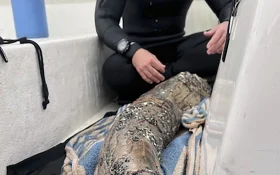Alex Lundberg, a fossil-hunting diver, recently discovered what he initially thought was a piece of wood on the sea floor off Florida’s Gulf Coast. However, upon closer inspection, Lundberg realized that the lengthy object was actually a large section of tusk from an extinct mastodon.
Lundberg and his diving companion had previously found fossils in the same area, including mammoth teeth, bones of an ancient jaguar, and parts of a dire wolf. They had also discovered small pieces of mastodon tusk, but nothing as large and intact as this recent find.
The tusk, measuring approximately 4 feet (1.2 meters) and weighing 70 pounds (31 kilograms), was found at a depth of about 25 feet (7.6 meters) near Venice, Florida. It currently resides in a glass case in Lundberg’s living room, but its story may not end there.
Mastodons, relatives of mammoths and present-day elephants, lived primarily in what is now North America, appearing as far back as 23 million years ago. They became extinct around 10,000 years ago, along with many other large mammals that disappeared during a period of rapid climate change and Stone Age human hunting.
Mastodon remains are commonly found across the continent, with Indiana even designating the mastodon as its official state fossil. The age of the tusk discovered by Lundberg has not yet been determined.
According to Florida law, vertebrate fossils found on state lands, including near-shore waters, belong to the state under the authority of the Florida Museum of Natural History. Lundberg, who has a permit to collect such fossils since 2019, must report the tusk find to the museum when his permit is renewed in December.
The museum will review the discovery and its location to determine its significance. If the museum does not request the tusk within 60 days of reporting, Lundberg can keep the fossil.
Lundberg, who has a marine biology degree and works at a prominent Tampa cancer center, is optimistic that he will be able to keep the tusk, describing it as a “cool piece” that has been “rolling around in the ocean for millions of years.”
The Associated Press contributed to this article.
